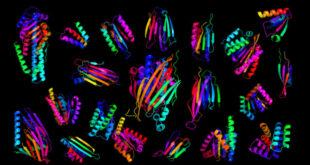Using dim, cooler lights in the evening and warmer lights in the day may be more beneficial to our health, according to a new study in mice from University of Manchester researchers.
Changes in the spectral content of ambient light are detectable to most mammals as a blue shift in the color of twilight. Mouland et al show that these blue colors suppress circadian responses to light, supporting robust circadian entrainment when environmental conditions render light intensity a weak or unreliable indicator of time of day. Image credit: Johannes Plenio.
“Twilight is both dimmer and bluer than daylight and the body clock uses both of those features to determine the appropriate times to be asleep and awake,” said senior author Dr. Tim Brown from the University of Manchester’s Centre for Biological Timing and colleagues.
“Current technologies designed to limit our evening exposure to blue light, for example by changing the screen color on mobile devices, may therefore send us mixed messages.”
“This is because the small changes in brightness they produce are accompanied by colors that more resemble day.”
The body clock uses a specialized light sensitive protein in the eye to measure brightness, called melanopsin, which is better at detecting shorter wavelength photons.
This is why scientists originally suggested blue light might have a stronger effect.
However, our perception of color comes from the retinal cone cells and this new study shows that the blue color signals they supply reduce the impact on the clock.
In their experiments, Dr. Brown and co-authors used specially designed lighting that allowed them to adjust color without changing brightness.
That showed blue colors produced weaker effects on the mouse body clock than equally bright yellow colors.
The findings have important implications for the design of lighting and visual displays intended to ensure healthy patterns of sleep and alertness.
“We show the common view that blue light has the strongest effect on the clock is misguided,” Dr. Brown said.
“In fact, the blue colors that are associated with twilight have a weaker effect than white or yellow light of equivalent brightness.”
“There is lots of interest in altering the impact of light on the clock by adjusting the brightness signals detected by melanopsin but current approaches usually do this by changing the ratio of short and long wavelength light; this provides a small difference in brightness at the expense of perceptible changes in color.”
“We argue that this is not the best approach, since the changes in color may oppose any benefits obtained from reducing the brightness signals detected by melanopsin,” he said.
“Our findings suggest that using dim, cooler, lights in the evening and bright warmer lights in the day may be more beneficial.”
The study was published in the December 16, 2019 issue of the journal Current Biology.
_____
Joshua W. Mouland et al. 2019. Cones Support Alignment to an Inconsistent World by Suppressing Mouse Circadian Responses to the Blue Colors Associated with Twilight. Current Biology 29 (24): 4260-4267; doi: 10.1016/j.cub.2019.10.028
 #Bizwhiznetwork.com Innovation ΛI |Technology News
#Bizwhiznetwork.com Innovation ΛI |Technology News




